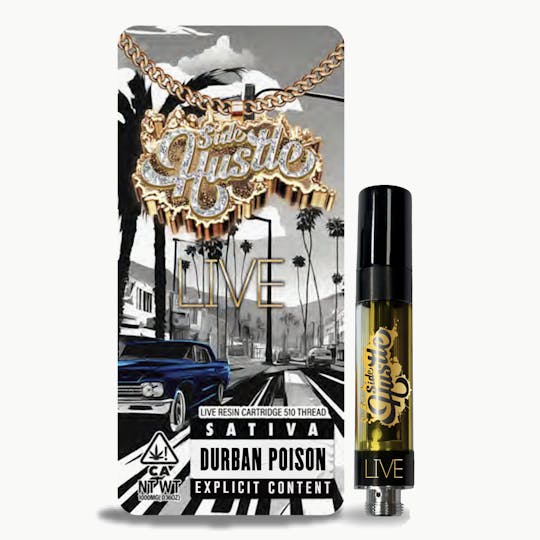
Durban Poison Live Resin Vape - Sativa - 1g
Coming soon Coming soon Coming soon Coming soon Coming soon
- Earthy
- Woody
- Spicy/Herbal
Side Hustle isn’t just about flower and vape distillates; it’s a mindset, a lifestyle. Crafted for young creatives and innovators who refuse to settle for the ordinary. Side Hustle embodies the pursuit of excellence and the drive to elevate every moment. We source the finest indoor-grown cannabis strains and distill them into pure, potent expressions of artistry. With seamless blends of flavor and effect, our vape distillates empower you to explore new frontiers of inspiration and productivity.
Join the movement. Embrace the Side Hustle lifestyle and redefine what it means to reach new highs. Elevate your experiences, amplify your creativity, and unleash your potential – because greatness knows no boundaries.
Durban Poison has deep roots in the Sativa landrace gene pool. The strain’s historic phenotypes were first noticed in the late 1970s by one of America’s first International strain hunters, Ed Rosenthal. According to cultivation legend, Rosenthal was in South Africa in search of new genetics and ran across a fast flowering strain in the port city of Durban. After arriving home in the U.S., Rosenthal conducted his own selective breeding process on his recently imported seeds, then begin sharing. Rosenthal gave Mel Frank some of his new South African seeds, and the rest was cannabis history.
Frank, who wrote the “Marijuana Grower’s Guide Deluxe" in 1978, modified the gene pool to increase resin content and decrease the flowering time. In search of a short-season varietal that could hit full maturation on the U.S. East Coast, Frank’s crossbreeding efforts resulted in two distinct phenotypes, the “A” line and “B” line. The plant from Frank’s “A” line became today’s Durban Poison, while the “B” line was handed off to Amsterdam breeder David Watson, also known as “Sam the Skunkman.”
Durban Poison has a dense, compact bud structure that’s typical of landrace Indica varieties, but the flowers’ elongated and conical shape is more characteristic of a Sativa.